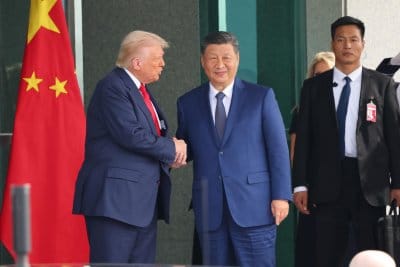1 of 4 | U.S. President Donald Trump and Chinese President Xi Jinping met in Busan, South Korea, on Thursday for a high-stakes meeting to negotiate their looming trade war. Photo by Yonhap
GYEONGJU, South Korea, Oct. 30 (UPI) — U.S. President Donald Trump departed from South Korea on Thursday after a highly anticipated meeting with Chinese President Xi Jinping that lowered the temperature on a simmering trade war with agreements on rare earth minerals, fentanyl, soybeans and tariffs.
The two leaders met for the first time since 2019 at Gimhae Air Base in the southeastern city of Busan, shortly after Xi arrived in the country for a three-day state visit to attend the Asia-Pacific Economic Cooperation summit.
Speaking to reporters on his way back to Washington aboard Air Force One, Trump described the outlines of a trade deal that he said would be signed “pretty soon.”
According to the president, China agreed to take steps to stop the flow of precursor chemicals used to make fentanyl into the United States. In response, Trump said he halved the 20% fentanyl-linked tariffs he had imposed earlier this year.
“Based on [Xi’s] statements today, I reduced it by 10%. So, it’s 10% instead of 20%, effective immediately,” Trump said.
The reduction brings the overall tariff rate on goods from China from 57% to 47%, he said.
Beijing also agreed to resume purchases of American soybeans and set a one-year pause on its planned export controls of rare earth minerals. China dominates the production and processing of the metallic elements, which are crucial for manufacturing a vast array of high-tech products from smartphones to missiles.
“We have not too many stumbling blocks now,” Trump said. “We have a deal. We’ll negotiate at the end of a year, but all of the rare earth has been settled.”
No official announcement from either side has been released yet, but the U.S. president declared the meeting a “great success.”
“Overall, on the scale of from zero to 10, with 10 being the best, I would say the meeting was a 12,” Trump said.
One topic the two leaders did not discuss was Taiwan, Trump noted. Some analysts had expected Xi to exert leverage in an attempt to soften U.S. support for the self-governing island of 23 million, which China sees as a breakaway province.
“I’m relieved Taiwan apparently didn’t come up in today’s meeting,” Sean King, senior vice president and East Asia expert at New York-based consulting firm Park Strategies, told UPI.
However, King said that the trade deal does not represent significant progress from when Trump kicked off his global tariff scheme in early April, on what the White House dubbed “Liberation Day.”
“We’re seemingly no further along than where we were on Liberation Day,” King said. “Unlike friendly leaders, Xi gave Trump no golden gifts … Right now, for better or worse, it seems like not too much of major trade substance happened in today’s meeting.”
At the start of the meeting, the two leaders had a brief introductory exchange that was open to the media.
“Given our different national conditions, we do not always see eye to eye with each other and it is normal for the two leading economies of the world to have friction now and then,” Xi said.
Xi called on Trump to join him and “ensure the steady sailing forward of the giant ship of China-U.S. relations.”
“I always believe that China’s development goes hand in hand with your vision to make America great again,” Xi said. “Our two countries are fully able to help each other succeed and prosper together.”
After the meeting, Xi traveled to the nearby city of Gyeongju to take part in the APEC Economic Leaders’ Meeting. Trump attended the APEC summit on Wednesday, where he struck a trade deal with South Korean President Lee Jae Myung and delivered a keynote address at a CEO luncheon.
